一、设计任务及要求
四人抢答器设计报告
1、设计用于竞赛的四人抢答器
(1)有多路抢答器,台数为四;
(2)具有抢答开始后 20 秒倒计时,20 秒倒计时后无人抢答显示超时,并报
警;
(3)能显示超前抢答台号并显示犯规报警;
2、系统复位后进入抢答状态,当有一路抢答键按下时,该路抢答信号将其余各
路抢答封锁,同时铃声响起,直至该路按键放松,显示牌显示该路抢答台号;
3、用 VHDL 语言设计符合上述功能要求的四人抢答器,并用层次设计方法设
计该电路;
4、完成电路全部设计后,通过系统实验箱下载验证设计课题的正确性。
二、四人抢答器框图及设计说明
系统复位后,反馈信号为一个高电平,K1、K2、K3、K4 输入有效。当抢
答开始后,在第一位按键后,保持电路低电平,同时送显示电路,让其保存按
�
键的台号并输出,同时反馈给抢答台,使所有抢答台输入无效,计时电路停止;
当在规定的时间内无人抢答时,倒计时电路输出超时信号;当主持人开始说话
未说完有人抢先按键时,显示犯规信号。当选手回答正确时加分,回答错误时
减分。由主持人控制加减分数。
三、设计思路:根据设计框图和设计要求,本次实验可以采用模块化设计方法
来实现智力竞赛四人抢答器。将抢答器划分为抢答鉴别保持模块,倒计时模块,
记分模块和判断显示模块。再利用元件例化语句将这四个模块组成总的抢答器
的设计电路。选用模式五进行程序的下载。
四、VHDL 语言设计与分析
1、鉴别模块
library ieee;
use ieee.std_logic_1164.all;
use ieee.std_logic_unsigned.all;
entity jianbie is
port(nu1,nu2,nu3,nu4:in std_logic;
clk,en,rst:in std_logic;
warn:out std_logic;
back:buffer std_logic;
s:out std_logic_vector(3 downto 0));
end jianbie;
architecture jianbiebeh of jianbie is
signal num,warnd:std_logic;
signal cnt:std_logic_vector(2 downto 0);
begin
num<=nu1 or nu2 or nu3 or nu4;
p1:process(rst, nu1,nu2,nu3,nu4,back)
--判断抢答信号
begin
if rst='1'
elsif
then
back='1'
back<='1';s<="0000";
then
�
if nu1='1' then
s<="0001";back<='0';
elsif nu2='1' then s<="0010";back<='0';
elsif nu3='1' then
elsif nu4='1' then
else back<='1'; s<="0000";
end if ;
s<="0011";back<='0';
s<="0100";back<='0';
--一号台抢答,输出 S 为 1
--二号台抢答,输出 S 为 2
--三号台抢答,输出 S 为 3
--四号台抢答,输出 S 为 4
--无人抢答,输出 S 为 0
end if;
end process p1;
p2:process(clk,en,back,rst,cnt)
then
cnt<="000";warnd<='0';
rst='1'
begin
if
elsif clk'event and clk='1' then
if en='0' and back='0' then
if cnt<"111" then warnd<=not warnd; cnt<=cnt+1;
else warnd<='0';
end if; end if;
end if;
end process p2;
warn<=warnd;
end jianbiebeh;
鉴别保持模块由两个进程组成,进程一主要用于鉴别强大信号,进程二用于
鉴别是否为超前抢答,若是超前抢答,则输出报警信号。其中鉴别保持模块的
波形如下:
�
如图所示,抢答开始前需要一个 RST 信号,其由主持人控制。当 RST 为
高电平时则抢答开始。输出 S 显示为抢答台号,当主持人还没有复位就有选手
抢答,则输出一个 WARN 的高电平信号。
2、计时模块
library ieee;
use ieee.std_logic_1164.all;
use ieee.std_logic_unsigned.all;
entity jishibaojing is
port(clk,rst,agree,stop:in std_logic;
warn:buffer std_logic;
cone:buffer std_logic_vector(3 downto 0);
cten:buffer std_logic_vector(3 downto 0));
end jishibaojing;
architecture jishibeh of jishibaojing is
signal cc:std_logic;
begin
p1:process(warn,clk,rst,agree,stop,cone)
--个位计时
rst='1'
begin
if
elsif
elsif clk'event and clk='1' then
stop='0'
then
cten<="0000";
then
cone<="0000";
cc<='0';
if agree='1' and warn='0' then
cone<=cone-1;
if cone="0000" then
cone<="1001";cc<='1'; end if;
end if;
end if;
end process p1;
p2:process(cc,rst,agree,stop,cten)
--十位计时
begin
if
then
elsif stop='0' then
rst='1'
cten<="0010";
cten<="0010";
�
elsif
cc'event and cc='1' then
if agree='1' and warn='0' then
cten<=cten-1;
end if;
end if;
end process p2;
p3:process(rst,cone,cten)
begin
--若 20S 内无人抢答,则报警
warn<=’1’ when(data="0000")
else ‘0’;
end process p3;
end jishibeh;
计时模块由三个进程组成:进程一为二十秒倒计时的个位计时;进程二为
二十秒倒计时的十位计时;进程三为二十秒倒计时计数完毕无人抢答,发出报
警信号。计时模块的波形如下:
如图所示,计时由二十开始,一直记到零零结束。其中如果有抢答信号则
重新从二十开始计数,为选手的答题倒计时时间。如果二十秒之内无人抢答,
则报警信号出现一个高电平。
3、记分模块
library ieee;
use ieee.std_logic_1164.all;
use ieee.std_logic_unsigned.all;
entity fenshu is
port(clk,rst,plus_s,sub_s:in std_logic;
s:in std_logic_vector(3 downto 0);
a1,a2,a3,a4:buffer std_logic_vector(3 downto 0));
end fenshu;
�
architecture fenshubeh of fenshu is
begin
process(clk,rst,plus_s,sub_s,s,a1,a2,a3,a4)
begin
if clk'event and clk='1' then
a1<=a2<=a3<=a4<=’0’;
--开始时,分数均为零
if rst='1' then
elsif s ="0001" then
if plus_s='1' then
--选手一抢答
--加分
if a1="1111" then
a1<="0000"; else a1<=a1+1; end if;
elsif sub_s='1' then
if a1="0000" then
end if;
elsif s= "0010" then
if plus_s='1' then
if a2="1111" then
elsif sub_s='1' then
if a2="0000" then
end if;
a1<="0000"; else a1<=a1-1;
end if;
--二号选手抢答
a2<="0000"; else a2<=a2+1;
end if;
a2<="0000"; else a2<=a2-1; end if;
elsif s="0011" then
-- 三号选手抢答
if plus_s='1' then
if a3="1111" then
elsif sub_s='1' then
a3<="0000";else a3<=a3+1; end if;
if a3="0000" then a3<="0000"; else a3<=a3-1;
end if;
end if;
elsif s= "0100" then
if plus_s='1' then
if a4="1111" then
elsif sub_s='1' then
if a4="0000" then
end if;
--四号选手抢答
a4<="0000";else a4<=a4+1; end if;
a4<="0000"; else a4<=a4-1; end if;
�
end if;
end if;
end process;
end fenshubeh;
计分模块仅有一个进程组成。若一号选手抢答,则开始给一号台计分,其
余也是如此。当分数记为“1111”时,再加分则为“0000”;当分数记为“0000”
时再减分时仍然为“0000”。其中记分模块的波形如下:
4、模块
library ieee;
use ieee.std_logic_1164.all;
use ieee.std_logic_unsigned.all;
entity segment is
port (sg_en:in std_logic;
sg_in:in std_logic_vector(3 downto 0);
sg:out std_logic_vector(6 downto 0));
end segment;
architecture one of segment is
begin
process(sg_en)
begin
if sg_en='0' then
if sg_in<=”0001”
if sg_in<=”0010”
then sg<=”0000110”;
then
sg<=”1011011”;
�
if sg_in<=”0100”
if sg_in<=”1000”
end if;
then
then
sg<=”1001111”;
sg<=”1100110”;
end if;
end process;
end one;
模块四连接数码管,当选控信号选择 1,则一号数码管显示;选控信号选
择 2,则二号数码管显示;选控信号选择 3,则三号数码管显示;选控信号选择
4,则四号数码管显示;
5、抢答器总模块
library ieee;
use ieee.std_logic_1164.all;
use ieee.std_logic_unsigned.all;
entity q_da is
port(clk,en,k1,k2,k3,k4,rst,plus,sub:in std_logic;
ring,warn:out std_logic;
cone,cten:buffer std_logic_vector(3 downto 0);
a1,a2,a3,a4:out std_logic_vector(3 downto 0);
s:buffer std_logic_vector(3 downto 0));
end q_da;
architecture bhv of q_da is
component jianbie is
--鉴别模块
port(clk,en,rst:in std_logic;
warn:out std_logic;
back:buffer std_logic;
nu1,nu2,nu3,nu4:in std_logic;
s:out std_logic_vector(3 downto 0));
end component;
component jishibaojing is
--计时模块
port(clk,rst,agree,stop:in std_logic;
�
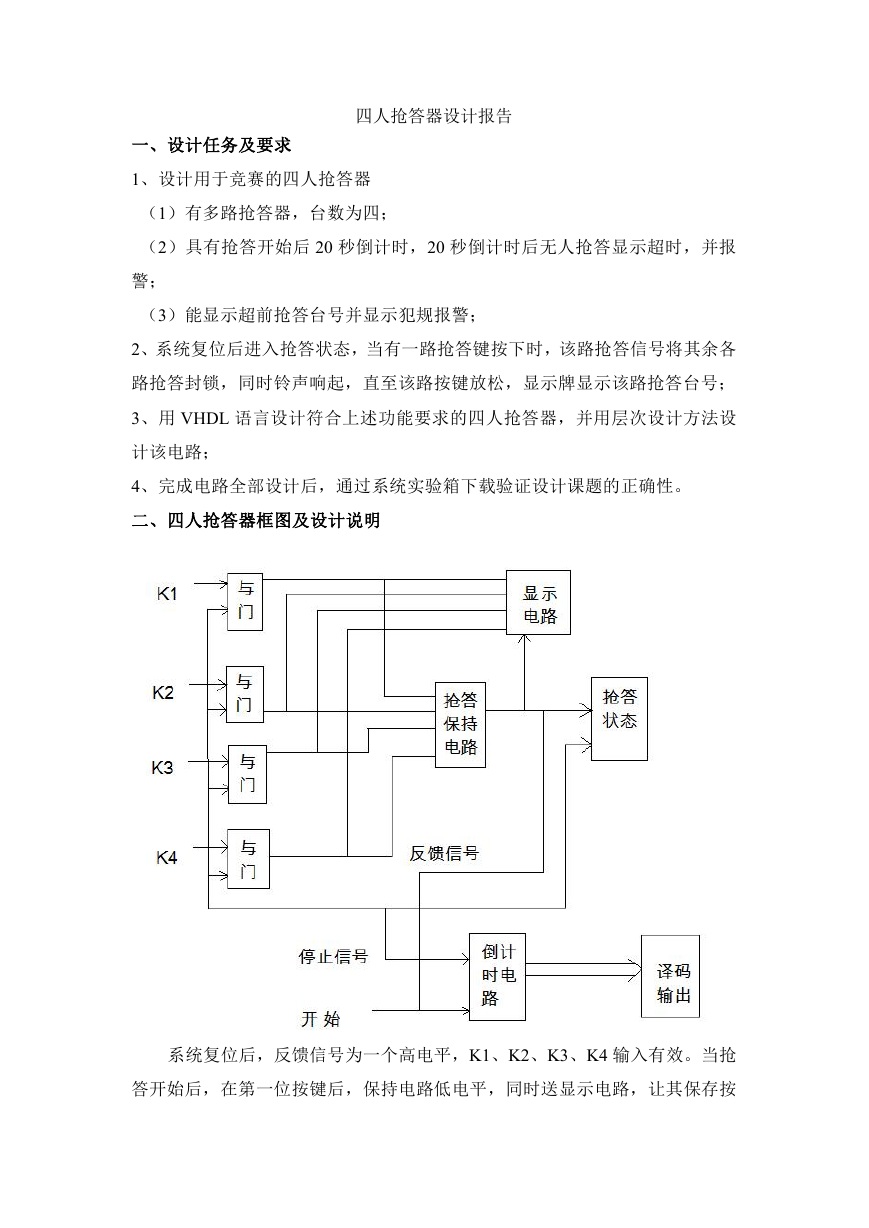
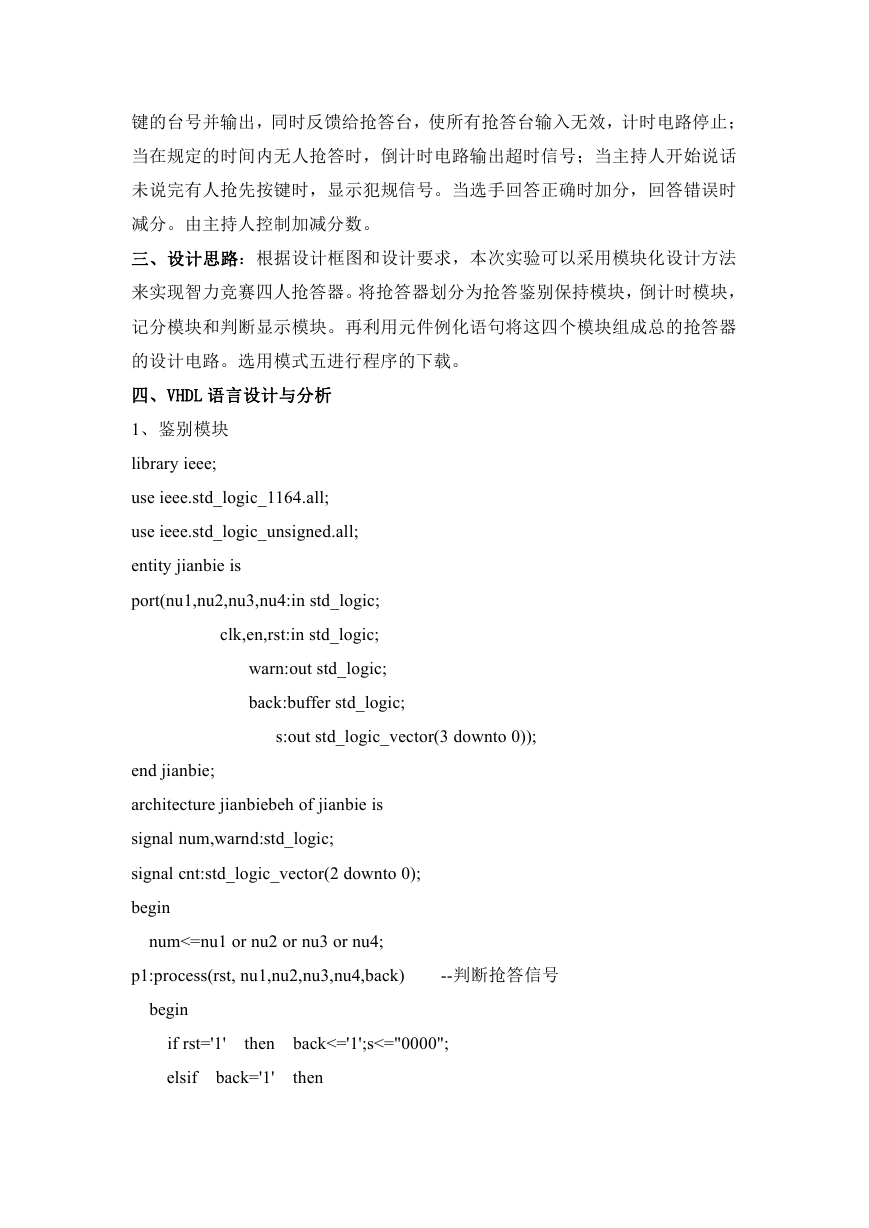
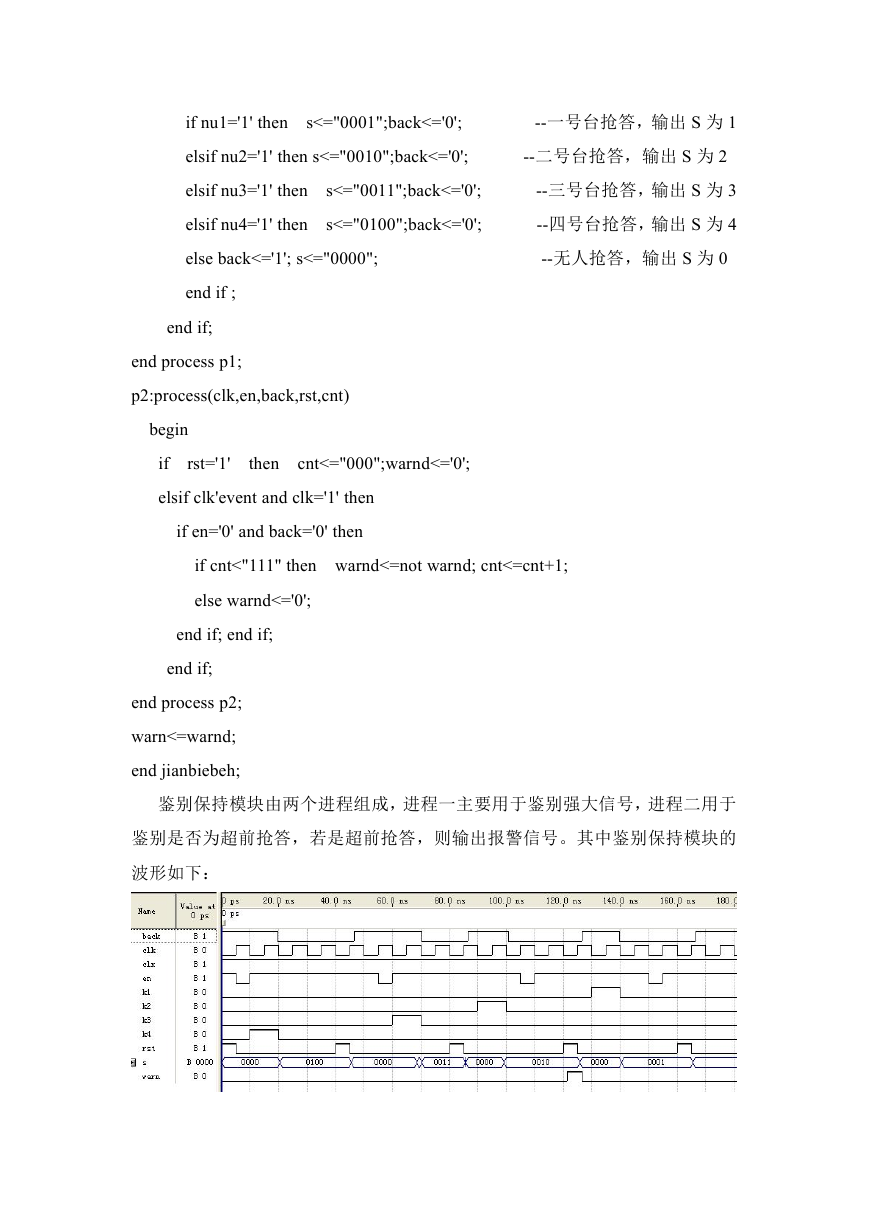
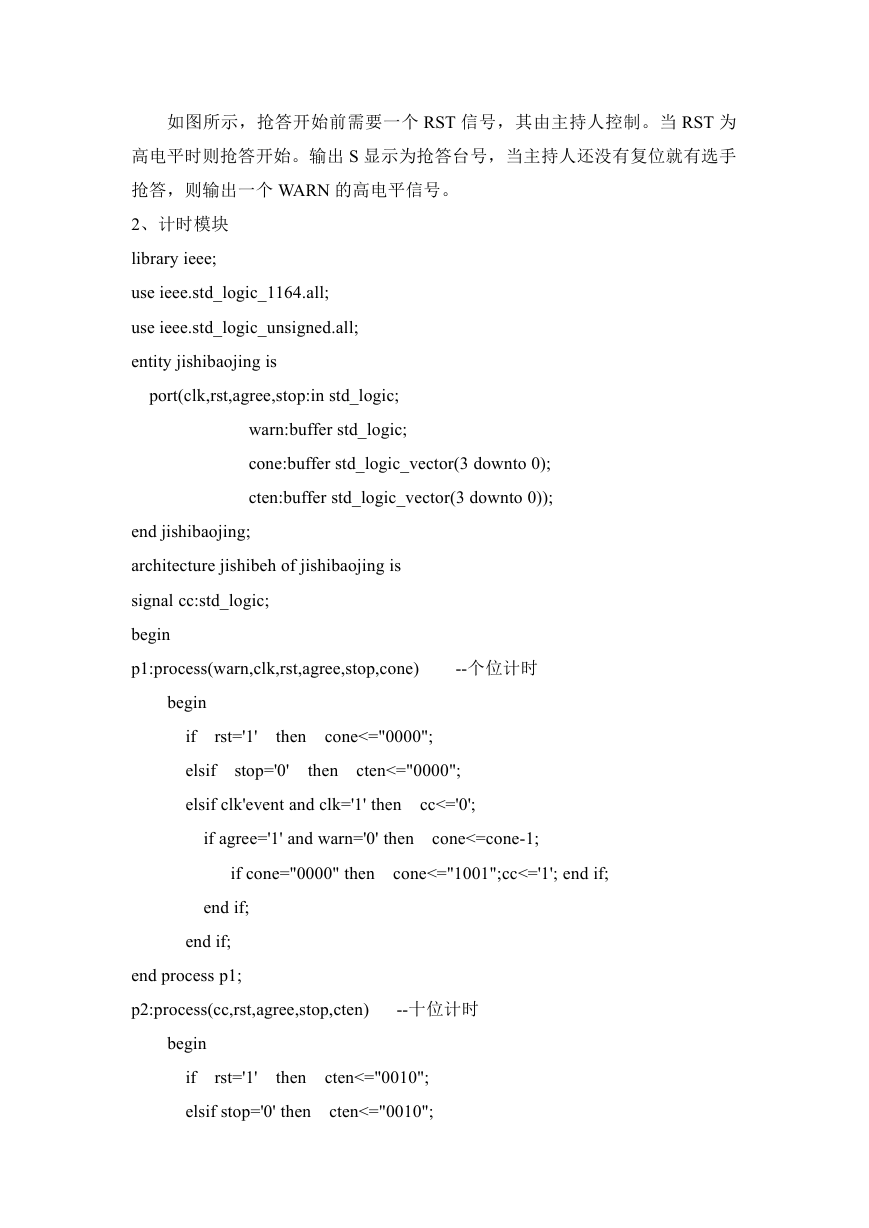
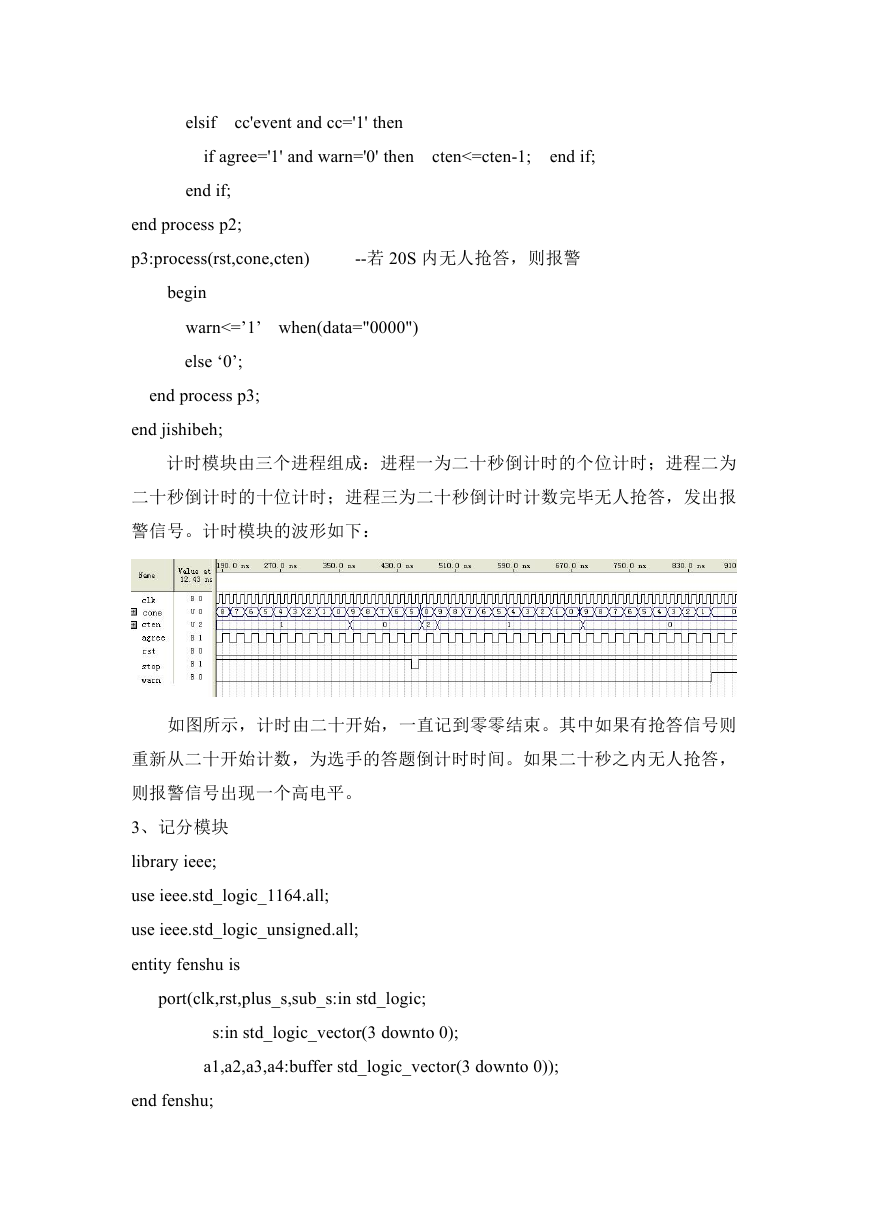
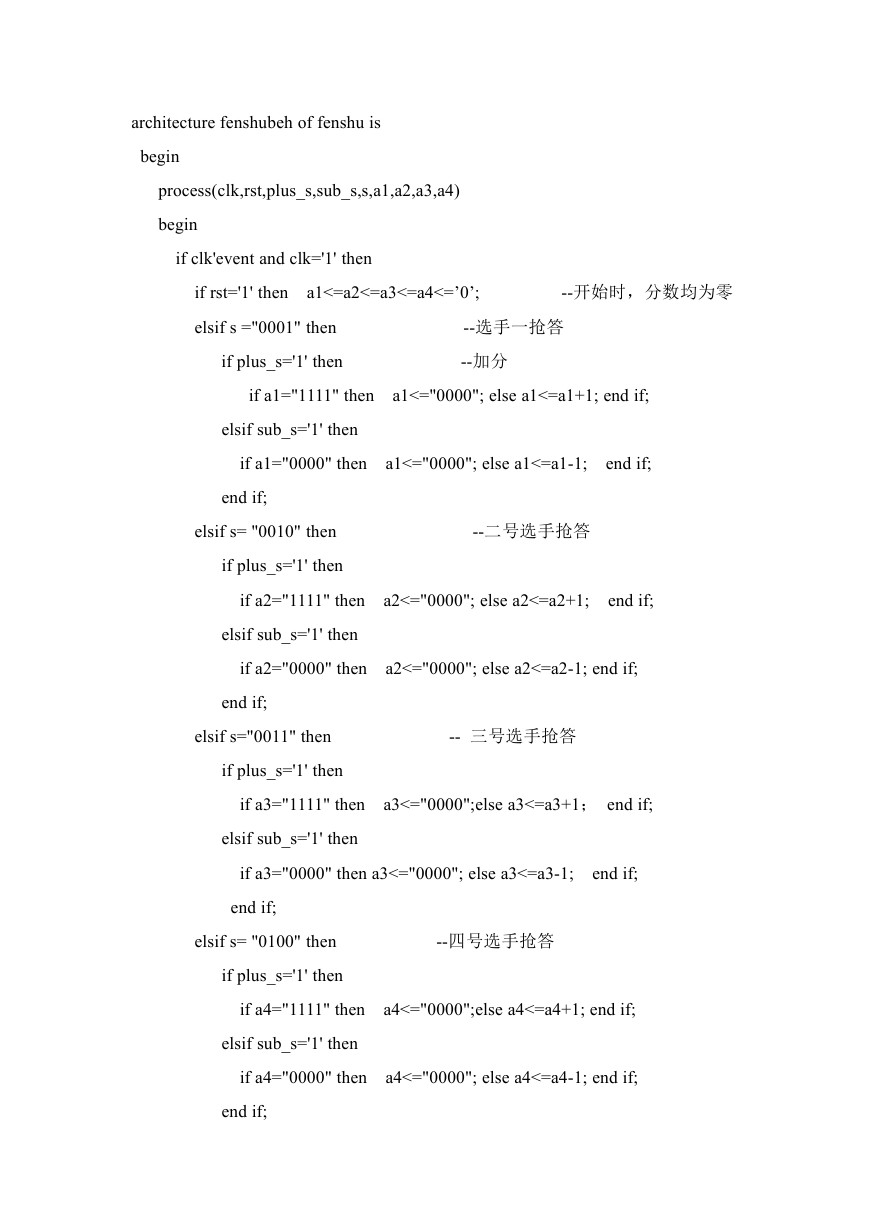
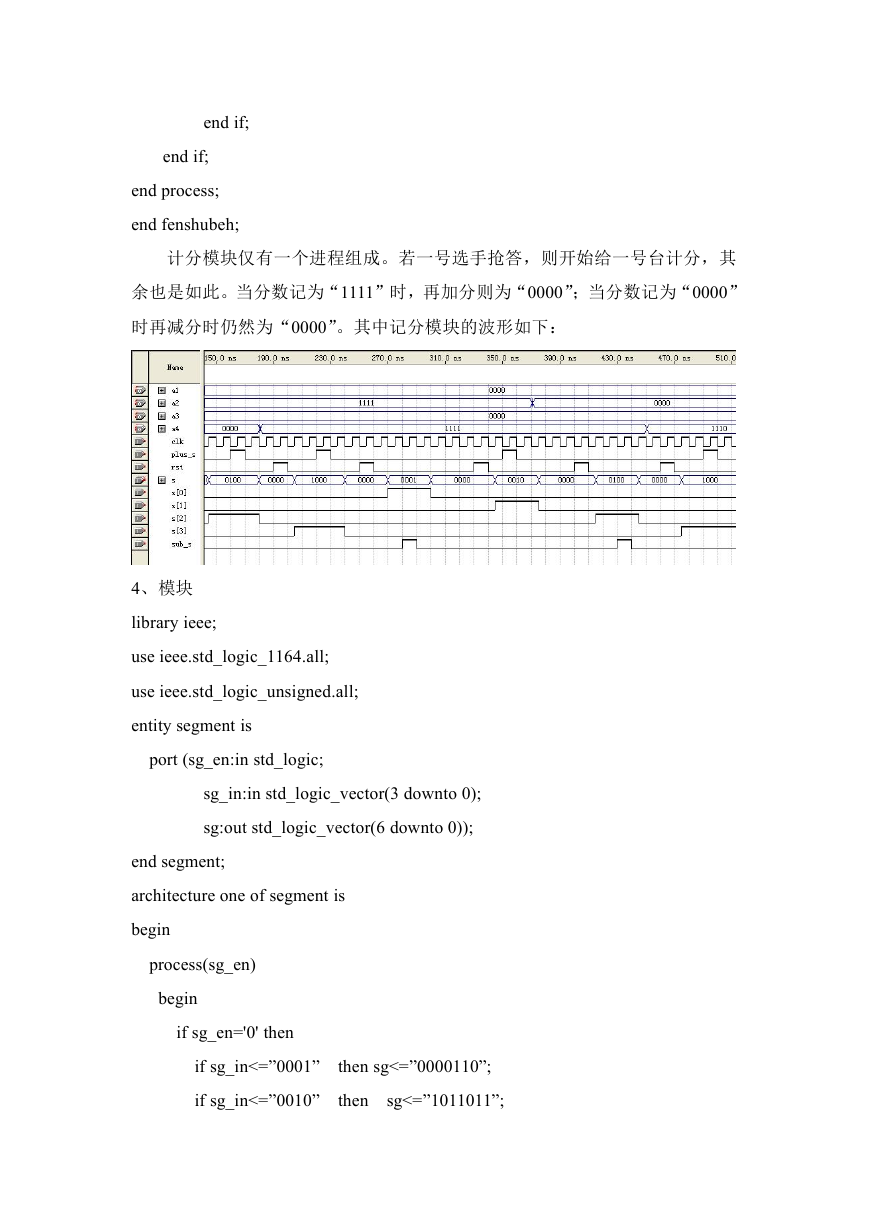
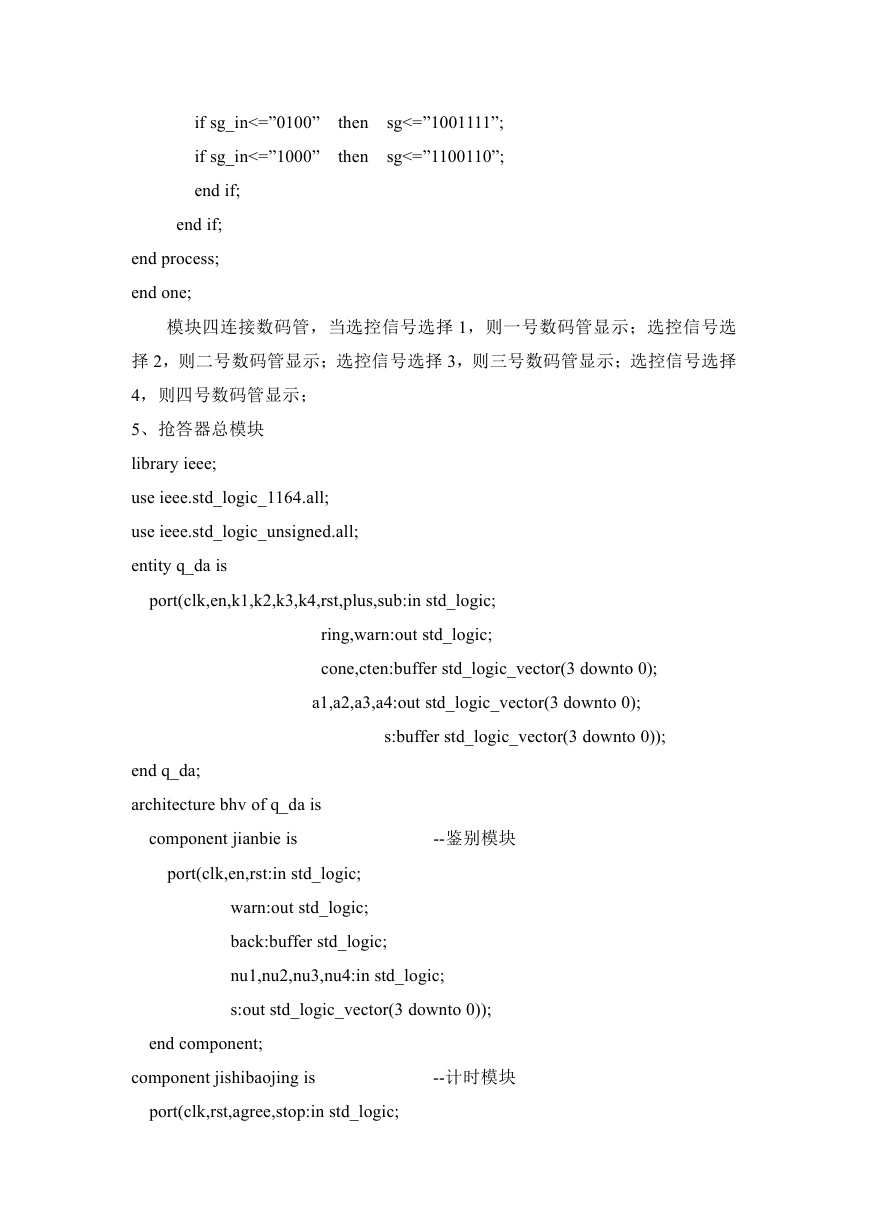








 2023年江西萍乡中考道德与法治真题及答案.doc
2023年江西萍乡中考道德与法治真题及答案.doc 2012年重庆南川中考生物真题及答案.doc
2012年重庆南川中考生物真题及答案.doc 2013年江西师范大学地理学综合及文艺理论基础考研真题.doc
2013年江西师范大学地理学综合及文艺理论基础考研真题.doc 2020年四川甘孜小升初语文真题及答案I卷.doc
2020年四川甘孜小升初语文真题及答案I卷.doc 2020年注册岩土工程师专业基础考试真题及答案.doc
2020年注册岩土工程师专业基础考试真题及答案.doc 2023-2024学年福建省厦门市九年级上学期数学月考试题及答案.doc
2023-2024学年福建省厦门市九年级上学期数学月考试题及答案.doc 2021-2022学年辽宁省沈阳市大东区九年级上学期语文期末试题及答案.doc
2021-2022学年辽宁省沈阳市大东区九年级上学期语文期末试题及答案.doc 2022-2023学年北京东城区初三第一学期物理期末试卷及答案.doc
2022-2023学年北京东城区初三第一学期物理期末试卷及答案.doc 2018上半年江西教师资格初中地理学科知识与教学能力真题及答案.doc
2018上半年江西教师资格初中地理学科知识与教学能力真题及答案.doc 2012年河北国家公务员申论考试真题及答案-省级.doc
2012年河北国家公务员申论考试真题及答案-省级.doc 2020-2021学年江苏省扬州市江都区邵樊片九年级上学期数学第一次质量检测试题及答案.doc
2020-2021学年江苏省扬州市江都区邵樊片九年级上学期数学第一次质量检测试题及答案.doc 2022下半年黑龙江教师资格证中学综合素质真题及答案.doc
2022下半年黑龙江教师资格证中学综合素质真题及答案.doc